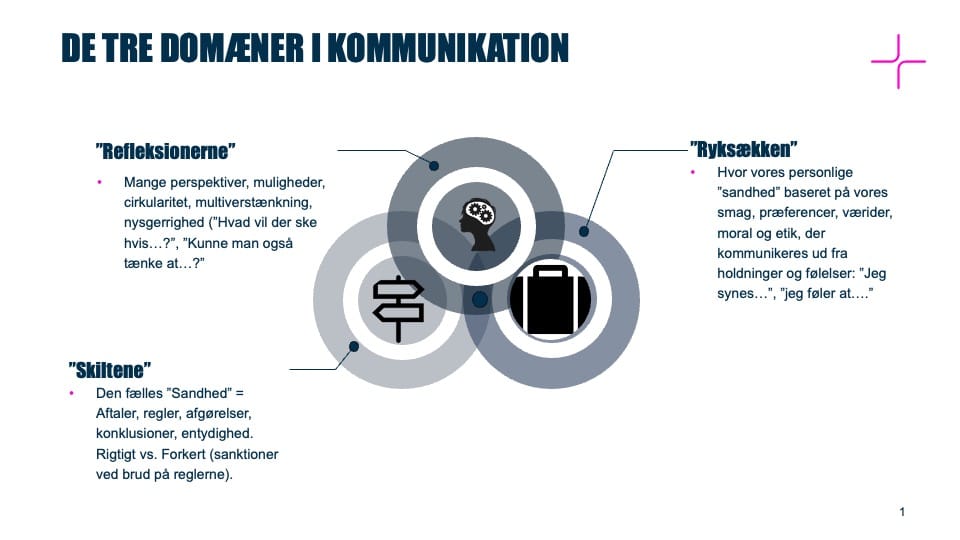Do you know what it's like when a simple misunderstanding leads imperceptibly to a disagreement that has suddenly turned into a conflict? And would you like to get better at picking up on the signs that it's about to happen - and get a few solid steps to turn things around? Then read on, where you - whether you're a manager, process leader, facilitator or colleague - will be introduced to a theory of communication that is as immediately applicable as it is touchingly simple.
Domain theory describes three different frames of meaning from which any statement can be understood. This is important because every situation is perceived (more or less) differently by the people involved in the situation. No situation carries its own meaning; meaning only emerges when we each start to piece together what is going on. The next step is to negotiate a shared meaning of what's going on. And it is this process of negotiating meaning that domain theory can help shed light on.
The basic idea is that all human communication can be broadly divided into three domains: the personal, production and reflection domains. First, we will present which logics govern each of the domains; then we will describe how the domains can be used in practice.
The personal domain
The personal domain is based on the "backpack" of attitudes, beliefs, values, preferences, etc. that we all carry around. These are formed from the experiences we bring with us and form the basis of our sense of self. This is where identity resides.
When we speak from the personal domain, we speak from personal taste and personal history. The communication has a subjective and often emotional angle, and there is a tendency for strong engagement with the issues being communicated. The domain is also called the aesthetic domain because our understanding of a situation is constructed based on subjective values of what is right and what is wrong. The personal domain is dominated by subjective truth.
In the workplace, the personal domain is typically brought into play when something clashes with how we think it should be. When colleagues, business partners or bosses are not behaving properly; when the framework conditions for our work do not allow us to do it well enough; when customers and citizens are unreasonable in their demands and expectations. Then we push the cuffs and protest from the personal domain.
The personal domain is in a sense superior to the other two domains: It's where our world goes and we always have our backpack with us. The personal domain is always lurking in the wings.
Read more about our training
Want to be even better equipped to manage processes?
The Process Consultant program gives you the methods to design, facilitate and lead strategic development processes and changes to create the impact you need.
This is an education for those who work with development, processes and change management.
The domain of production
In the domain of production, objective truth reigns supreme. Communication here takes place with implicit reference to the fact that this is the way it is. Not because we think, feel or experience it, but because those are the rules.
The ideal in the domain of production is clarity and the goal of our communication is to decide, conclude and act. When we speak from the domain of production, we speak technically, formally and professionally, and there is no invitation for nuanced or qualifying dialog.
In the workplace, the domain of production is found in the written and unwritten rules, procedures and guidelines we rely on when working together to accomplish tasks - whether they are formulated as objectives, procedures, policies, visions, job and function descriptions or something else entirely. It is the organization's rules of the road that enable us to regulate and adjust our behavior in relation to each other, thereby building workflows, routines and positive habit patterns.
The production domain is where we spend most of our time in the workplace. If there is any doubt about a workflow, another sign is put up from the production domain. At the same time, it is the domain's strength and limitation. As the complexity of an organization increases, more and more signs and regulations are put up, with the risk that the members of the organization will eventually not be able to see their own behavior for the signs.
Misunderstandings can be resolved relatively easily within the production domain. However, disagreements and conflicts arise when communication from the production domain clashes with communication from the personal domain. When colleagues interpret the unwritten common ground rules differently or there is no support for following what has been agreed. Sparks can fly and there is a need to take communication into the third domain.
The domain of reflection
In the domain of reflection, there are no preconceived solutions, no right or wrong, but instead the exchange and development of ideas and new possibilities. The success criterion in this domain is not to agree, but to create new perspectives, new understandings and new possibilities for action beyond the tried and tested.
The domain of reflection is characterized by stepping back and taking a meta-position from which it is possible to examine a given phenomenon more closely. Communication in the domain of reflection is characterized by responsiveness and curiosity towards others' perspectives.
The premise of the domain is the acceptance that there are many equal versions and interpretations of reality. What is interpreted as right and wrong from the personal or production domain is temporarily set aside. Instead, a dialogical and curious position is adopted, from which it becomes possible to take different perspectives that are not mutually exclusive
The purpose of communication from the domain of reflection is learning and new insights. Acknowledgement in a broad sense is a prerequisite for stepping into this position, where we let go of our own truths for a while to put ourselves in a wondering, exploring and meaning-seeking position with room for many different perceptions.

The art of implementation
We offer management and organizational sparring, research-based training and presentations on implementation as well as training courses with a specific focus on giving you and your organization general implementation skills. Read examples of our services here.
How to put domain theory into practice
Knowledge of the domain theory can be used in two general ways in everyday encounters and dialogues at work:
- Listening for which domains are being communicated from
- Asking questions so that the dialog is circulated and qualified through visits to all domains
What the three domains have in common is that they each seem obvious to the speaker. When you communicate from a domain, what you say will generally seem logical and reasonable to you. And in most cases, it will also be perceived as such by others in the same domain. Misunderstandings, disagreements and conflicts arise due to a lack of clarity about which domain is being communicated from - or if people are communicating from different domains.
Paying attention to the domains can help clarify whether what's on the agenda is:
- An exchange of attitudes or opinions (the personal domain)
- An agreed decisionthat has been announced and simply has to be followed. It is therefore not up for debate whether, for example, a new management system should be implemented, but only how to use it in practice (the domain of production)
- An invitation to collaboratively generate new thoughts and angles on a topic (domain of reflection)
When leading a meeting or process, it's often beneficial to be mindful of moving the conversation around all three domains. Most conversations will naturally move into both the personal and production domains; as a general rule, it is more difficult to move the dialog into the reflection domain. This is where active facilitation is needed.
A good basic structure is to start in the personal domain, then explore new perspectives in the domain of reflection, and then land the meeting in the domain of production. Let's look at an example.
The teaching team for the B and D class at Nyskolen in Xkøbing, Denmark, has gathered to discuss how best to deal with a handful of students who are causing unrest in the classes. The team coordinator leading the team meeting has organized the process in this way:
- The personal domain: Everyone shares their opinions on a topic. A brief tour of this domain clarifies the intentions and needs of the meeting participants. The pitfall here is that we end up in a discussion about whose opinion or "view" is more valid. The most deadly meetings are those that remain in the personal domain in an attempt to convince others of our own views and interpretations.
- The domain of reflection: Everyone explores to better understand what's behind what others are saying. Everyone helps to create new perspectives and syntheses. Brainstorm options for action that correspond to the intentions that have been uncovered.
- The domain of production: A decision is made on what to do next. A conclusion or goal is formulated. Discuss how we can contribute to the achievement of the common goal on a daily basis.
Domain theory is a popular tool for process consultants, coaches, facilitators and process leaders. Of course, as with any other model, it must be used with a certain amount of flexibility and sensitivity. If it becomes a method that is imposed on every meeting or dialog, it dilutes itself and loses its power. However, if used wisely by moving conversations around the different domains, misunderstandings can be clarified, disagreements resolved and conflicts softened. For the benefit of both wellbeing and task performance.




